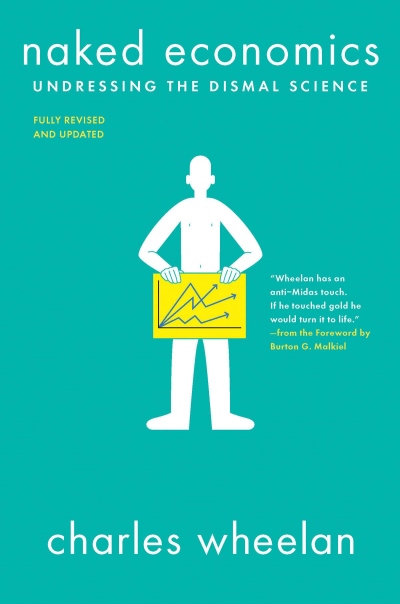
2 Sentence Summary
“Naked Economics” by Charles Wheelan is a book that breaks down the complex subject of economics so that the average reader can understand what makes an economy thrive or fail. It offers clarity into the morals, ethics, and regulations associated with economic decisions.
Summary Read Time: Less than 5 minutes
Actual Book Length: 400
First Published in: 2002
Below is the detailed yet quick summary of the book:
Chapter 1 – The Power of Markets: Who feeds Paris?
Capitalism is built on the idea that individuals working for their own best interests will ultimately lead to a thriving and ever-improving standard of living for most members of society. This system relies on the market to align incentives in such a way that everyone benefits from the success of businesses and individuals. When it works well, capitalism results in a rising standard of living and greater opportunity for all.
Every day, billions of transactions take place to ensure that the right amount of goods end up where they are needed. This usually happens without government involvement. In a market economy, resources are allocated where and when they are needed. This is in contrast to a regime like the Soviet Union, where the state directed everything.
Everyone has different preferences, and they devote their resources to different goods, causes, and services. We shouldn’t impose our own preferences on individuals living vastly different lives. For example, environment conservation is often not a primary concern of famished communities.
A key tenant of economic theory is that individuals are always looking to improve their lives. To do this, they weigh the benefits and costs of their choices – often referred to as a trade-off. For example, an individual may choose to forgo an immediate benefit for a greater future benefit.
Chapter 2 – Incentives Matter
Incentives matter. People work harder when they’re motivated by things like commission-based pay. In systems that don’t rely on market economy, personal incentive is not linked to productivity. This means that people have no reason to do more or better work, which can lead to inefficiencies.
For example, as teachers’ salaries are not linked to performance, the best ones tend to choose other careers while the lazy ones become teachers. Their incentives are opposite.
Good policy incentivizes people to behave in a way that leads to the desired outcome, while bad policy either doesn’t take incentives into account or fails to predict how people will change their behavior in response to them. For example, a perverse incentive can lead to the Indian snake infestation problem.
Misaligned incentives are a big problem – especially when it comes to something as important as finance. For example, back in 2008 the credit rating agencies gave the highest ratings to toxic financial instruments. But the reason they did this was because the firms that were selling those assets were the ones financing the agencies.
Chapter 3 – Government & The Economy – Part 1
An externality is an economic term that refers to a cost or benefit that is incurred or received by a party that is not directly involved in the transaction. For example, if you purchase a car for $x, the external cost to society of the higher CO2 levels and exhaust fumes emitted by the car is not borne by you directly.
The market cannot be relied on to improve environmental conditions or reduce pollution. In fact, it typically makes these problems worse. Fortunately, governments can intervene by banning certain products or imposes taxes (higher taxes on polluting vehicles → less people buy them, but are still free to do so if they are OK with the cost incurred). This way, we can all work together to make the world a cleaner and better place for everyone.
For more routine matters, parties can come to an agreement without government intervention and will reach a mutually beneficial solution.
Good government is necessary for markets to prosper by issuing laws and protecting property, while bad governments can send them into decline.
The government is responsible for providing the public goods that make us all better off, but these are things that the private sector would not provide. For example, private entities do not pay for public lightning. That’s because it benefits everyone and there would be too many people taking advantage of the service without paying anything.
Chapter 4 – Government & The Economy – Part 2
Governments can be useful, as previously explained, but they can also stifle innovation and make things worse. Governments should not be the only providers of a good/service unless there is a reason to think that the private sector will fail in that role (e.g. the defense sector, but not the postal service).
The work that needs to be done should be attributed to the best private bidder so that the public good is delivered in a way that benefits from the market.
In the private sector, markets show us where it is most beneficial to invest our resources because this is where they will be of the most value. However, when governments get involved and interfere with that process, it creates problems. The USSR was able to beat the United States in the Space Race because the government decided to invest its resources into that enterprise, even though it was not what the people would have preferred.
Regulation prevents the free flow of resources that would otherwise be dictated by the market, and taxation makes people less likely to want to work or invest.
Chapter 5 – Economics of Information
What we don’t know can really hurt us – especially in markets where information is power. The party that knows more often comes out on top, but if the imbalance is too big, it can lead to market instability or even collapse. When one side takes advantage of the other’s lack of knowledge, we call it adverse selection.
Branding can be a helpful way for consumers to decide which options to choose, especially when quality and safety can only be assessed after purchase and use. With a branded product, you know what you’re getting no matter where you are; with unbranded products, you don’t know what you’re going to get. Branding provides the trust that’s necessary in capitalism.
From the producer point of view, branding also solves the problem of sale prices being pushed toward production cost because of competition. Producers can charge more for products made under a respectable brand.
Chapter 6 – Productivity & Human Capital
Bill Gates is most likely much richer than you because he has a lot of human capital.
Human capital is the sum of all the skills and talents that an individual has. It’s what makes you unique and in demand, and therefore, better compensated. Investing in human capital today yields returns in the future, just like any other investment. In fact, human capital makes up the vast majority of the wealth of modern economies, while natural resources play a very small role (think Nigeria vs Japan).
Productivity growth is essential for improving the standard of living for a population. It is not a zero-sum game, as other populations get richer they can afford goods and services that were previously unaffordable, making everyone better off. But productivity growth depends on investment in human capital, monetary investment, research and development, etc. We have to spend money now in order to see returns in the future.
Globalization creates more opportunities for skilled workers while leaving the unskilled workers worse off in the short run, since it increases competition. But as a whole, the pie grows larger. The question is how much should we care about the size of the pieces, but there is no unanimous answer.
Chapter 7 – Financial Markets
Any personal investment strategy must obey the laws of economics. All financial instruments are based on 4 needs:
1: Raising capital (e.g. through issuance of bonds or shares)
2: Storing, protecting and making profitable use of excess capital
3: Hedging/Insuring against risk (e.g. future contracts, akin to insurance)
4: Speculation (not the primary purpose, but financial instruments facilitate this, as was the case with CDS in 2008)
It’s no simple task to become rich through investing in the market – and we’re not talking about get-rich-quick schemes. Everyone is looking to make the most of their money and they have access to the same information, which is used to determine prices. This is why it’s difficult to outperform the market. It’s the unpredictable things that make a difference. The average investor is better off investing in an Index fund.
But is the market always rational? No, because humans are prone to making behavioral errors. However, over time these inefficiencies tend to correct themselves.
Chapter 8: The Power of Organised Interests
Political actions are often counter-productive, economically-speaking. They bring votes, but they also incur costs that are spread over a large, unorganized part of the population. This leads to inefficiencies in the market economy, and it begins to disrupt the efficient flow of inputs and outputs.
Chapter 9 – Keeping Score of Economy
Why does every economy go through periods of growth and recession?
Gross Domestic Product (GDP) is the total sum of all goods and services produced in an economy. That’s the metric economists use to talk about growth. But it’s important to differentiate between real GDP (which takes inflation into account) and nominal GDP (which doesn’t). And to compare GDP between different countries, we need to use GDP per capita (GDP divided by total population) so we’re looking at apples-to-apples numbers.
Can real GDP be used to measure the well-being of a nation ? The answer is both yes and no. GDP can be used as an indicator of a nation’s well-being for a few reasons. Firstly, a nation cannot consume more than its GDP (through direct consumption and trade). As GDP per capita grows, the nation becomes richer, and the time of work needed to buy an item decreases, even though the price of the item may increase.
However, GDP does not take into account many things. Some of them are environmental degradation (cutting down a forest increases GDP but the loss is not accounted for), work done at home, benefits from leisure time, wage disparity. For this reason, some people argue that GDP is not an accurate measure of a nation’s well-being.
The definition of economic progress is important to consider when evaluating any claims of improvement. For example, if we’re using a measure of progress that only looks at financial growth, we might miss other important aspects of economic development. When people experience a loss in income, they often spend less, which can have a ripple effect on the economy as a whole. Our collective beliefs about the future of the economy can become a self-fulfilling prophecy.
Chapter 10 – The Federal Reserve
The Federal Reserve is made up of 12 Reserve Banks located across the United States, as well as a 7-person Board of Governors in Washington, D.C. Its goal is to regulate commercial banks and support the banking infrastructure, as well as manage the country’s monetary policy.
The Federal Reserve essentially has the power to control how much money is in circulation within the United States economy at any given time. They do this by changing interest rates. When the rates are lowered, it encourages spending and investing because it becomes cheaper to borrow money. When rates are raised, it has the opposite effect and people are less likely to spend because it becomes more expensive to borrow.
Why shouldn’t we leave the tap open? Because there are limits to the rate at which an economy can grow. If growth rates stay too low for too long, demand for many goods will overwhelm what can be produced, which will increase prices and wages of workers, and inflation will take hold. No one is better off from inflation, and it is hard to stop.
The speed limit of the US is somewhere close to 3% GDP growth per year. Thus the Fed has to keep a fine balance given this imprecise variable.
Chapter 11 – International Economics
International transactions should make all parties better off.
A government that deliberately keeps its currency undervalued is taxing consumers of imports and subsidizing producers of exports. An overvalued currency does the opposite, making imports artificially cheap and exports less competitive with the rest of the world.
The goal of global economic policy should be to make it easier for nations to cooperate with one another. The better we do it, the richer and more secure we will all be.
Chapter 12 – Trade & Globalization
Trade is essential for modern economies because it allows both parties to benefit.
Trade improves our wealth by freeing up our time and resources to do things we’re good at. This process is called specialization and it leads to increased productivity and wealth.
While trade can create losers in the short run, it also creates new jobs in the long run.
Protectionism may save jobs in the short term, but it ultimately slows down economic growth. This is because protectionism does not favor specialization. As a result, globalization favors specialization.
Trade lowers the cost of goods for consumers, which is the same as raising their income.
Trade is also good for poorer countries because it is based on voluntary exchange. Voluntary exchange occurs when both parties involved in a trade are better off after the trade than they were before.
Chapter 13 – Development Economics
If there’s one thing that all successful countries have in common, it’s a highly educated workforce. Human capital is what makes individuals productive, and productivity is what determines our standard of living. All countries that have had persistent growth in income have also had large increases in the education and training of their labor forces.
This is especially true for developing countries, where higher rates of education for women are associated with lower rates of infant mortality. So if you want to improve your standard of living, get some education and training! It will pay off in the long run.





